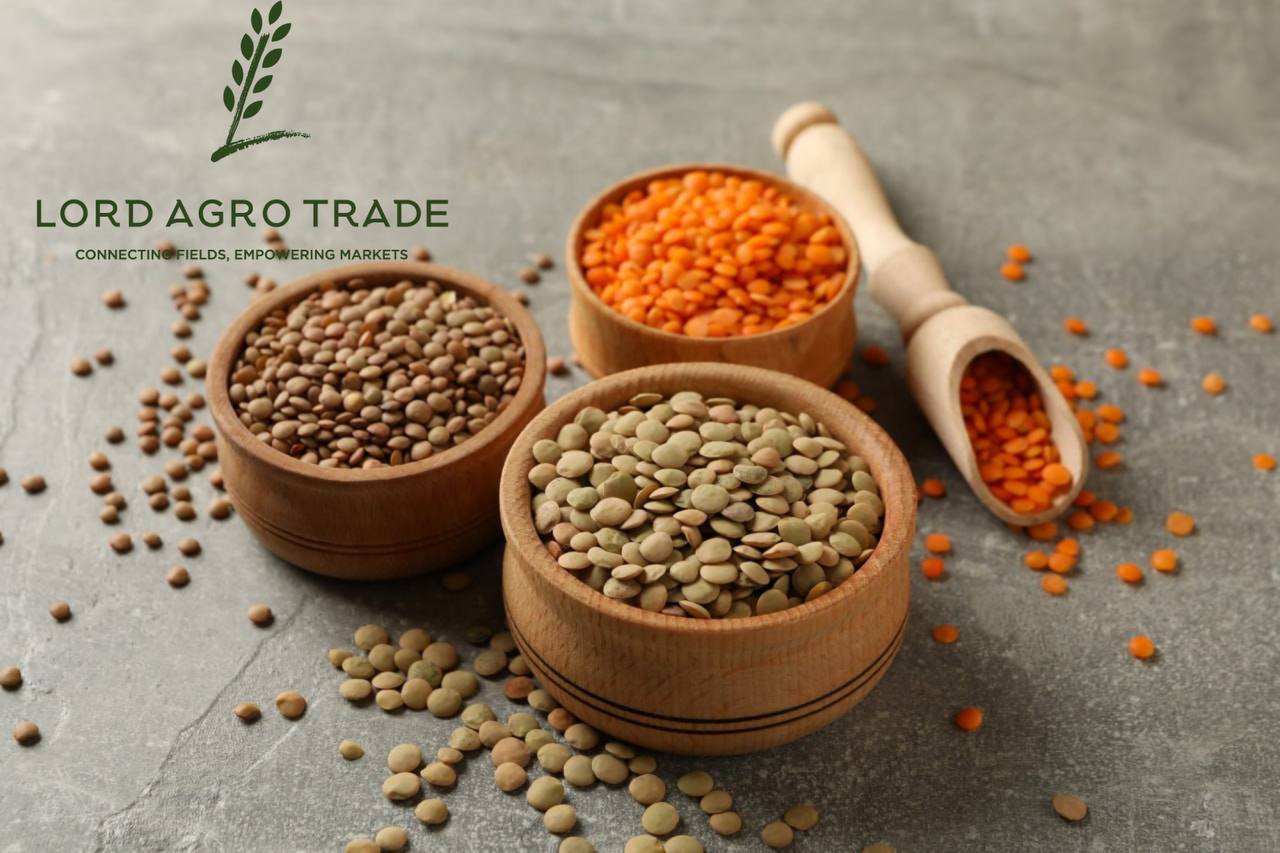Gulfood
17 To 21 FEB 2025 | DUBAI WORLD TRADE CENTRE
We’re excited to see you at Gulfood 2025!
Gulfood
17 To 21 FEB 2025 | DUBAI WORLD TRADE CENTRE
We’re excited to see you at Gulfood 2025!


Lentil export is one of the main components of international agrarian trade. This crop has a significant position in international commerce due to its high nutritional value and demand in global markets. Countries leading in the production and export of lentils can leverage this opportunity to increase revenue and expand their market reach.
However, one of the major challenges in lentil export is the issue of pests. Pests in the export of lentils not only affect the quality of the product but can also result in the rejection of shipments at international borders. This may lead to substantial financial losses and reduced buyer confidence. Pests can damage lentils at every stage, from harvest, storage, and transportation, and may cause infestation, deterioration in quality, and even an embargo on importation by other countries.
Effective pest management and control within the process of lentil export is very crucial. It can be further improved in terms of quality of product, export value, and expanded target markets by adhering to sanitary standards and adopting modern methods of pest control. This article explores strategies and suggestions for reducing and managing pests in lentil exports, emphasizing the importance of such a factor for success within global markets.
Most varieties of lentil exports have problems with different kinds of pests that compromise the quality and acceptability of the produce in international markets. Identifying these pests and understanding their effects are useful in the implementation of control measures against them. The most prevalent pests that attack lentils during export are outlined below.
Insects are some of the most serious storage and transport hazards for lentils. They include:
Beetles: Different species, such as bruchid beetles, are able to infest lentils and it leads to the deterioration of the lentils by creating holes in them thus, quality decreases through visual fatigue and loss of nutrients.
Weevils: The maternal insects lay their eggs in the lentil grains and this can result in an internal infestation that cannot be traced easily before the bag’s shipping.
Insects not only degrade the physical quality of lentils but also raise concerns about contamination, leading to rejection in export markets.
Another main problem is fungal infections and mold growth which is the most common during the storage of lentils in high moisture conditions. Aspergillus and Penicillium species are the most prevalent among them: They are the key disease-causing organisms though. Visible Mold: Highly reduces the marketability of lentils and sometimes causes failure in quality assessment.
Mold and fungi not only attack the safety and quality of the lentils but also result in poor perceptions among foreign buyers.
3. Storage Pests
Those pests specifically attack lentils during long shipments or for long storage periods: Rodents: Mice and rats can contaminate the lentils with excreta besides causing physical damage to packaging. Mites: These microscopic pests may infest bulk lentils, thus rendering them unfit for food.

Recommended page: Lentil quality standards
Storage pests are common in poorly managed facilities, which often result in huge losses in export value. Quality and Marketability of Lentils They can gather the lentil supply only if the local farmers approve of their project, otherwise, everything will just go into the ditch: Reduced Quality: Infestation makes the texture, appearance, and nutritional worth of lentils hurt; the infected ones are insipid to the buyers. Health Hazards: Polluted lentils pose a risk to the health of the people, as they could have toxic substances or disease-causing bacteria that were passed on by the pests.
Market Rejection: Countries importing lentils have strict phytosanitary regulations, and any sign of pest infestation can result in shipment rejection or quarantine measures.
The issue of Pests in the export of lentils is important to ensure product integrity, customer trust, and international trade standards. Proper pest management strategies can help mitigate these risks and ensure successful exports.
The appearance of Pests in the export of lentils presents some issues that interfere with trade, worsen economic dynamics, and prevent meeting the thresholds required for international standards. Below is a more detailed exploration of these challenges:
The economic consequences of Pests in the export of lentils are manifold:
Quality Downgrades: Pest infestations reduce the appearance, nutritional content, and overall quality of lentils. Consequently, lentils with pests cannot compete in global markets. Price cuts or even total rejection by buyers are often the direct outcomes of these situations.
Direct Financial Losses: Pests in the export of lentils lead to rejected shipments, causing immediate financial losses. Exporters may incur additional costs for fumigation services, as well as expenses for shipping the contaminated goods back to suppliers.
Increased Operational Costs: Frequent infestations from Pests in the export of lentils require additional funding for secure storage, advanced pest control techniques, and regular quality checks, which significantly increase operational expenditures.
Loss of Long-Term Contracts: Trade parties receiving shipments with pest issues may terminate business relationships altogether, resulting in the loss of valuable long-term trade opportunities.
Stringent international regulations create significant challenges for exporters in managing Pests in the export of lentils:
Compliance with Importing Countries’ Standards:
Many countries require agricultural products, such as lentils, to be completely free of pests and demand detailed certification processes.
Strict measures ensure compliance, and cases of non-compliance, such as the detection of Pests in the export of lentils, can lead to severe penalties, including isolation (denial of shipments) and stigmatization (blacklisting for future exports).
Quarantine Risks:
There is a high risk that Pests in the export of lentils will lead to orders being detained for extended periods, resulting in delivery delays and increased financial burdens.
In cases of severe infestation, shipments may either be sent back to the exporting country or destroyed entirely, further amplifying economic losses.
Updating Regulatory Requirements:
Importing countries frequently update their phytosanitary and safety standards. Addressing the risk of Pests in the export of lentils requires exporters to adapt, often involving significant investments in new compliance systems and processes.

More information: Export of green lentils and red lentils
Damage to Brand Reputation: Persistent pest-related issues, such as pests in the export of lentils, tarnish the credibility of exporters. International buyers, who are more likely to lean toward pest-free suppliers, will often steer clear of regions dealing with recurring pest outbreaks.
Restricted Market Access: Pests in the export of lentils can lead some countries to implement import bans or add restrictions on shipments from regions with a pest problem; thereby, redirecting the market toward exporters with effective pest control strategies.
Competition Pressure: Furthermore, exporters from areas that have installed effective pest control methods can outpace others dealing with pest problems, including pests in the export of lentils, all through the globe.
4. Supply Chain Disruptions
Hold Up in Delivery: Pest infestations, such as pests in the export of lentils, which could be discovered during the journey or at survey points, may delay shipment delivery. Such delays risk breaking contracts and causing customer dissatisfaction.
Storage Risks on the Rise: Continuous storage caused by delayed shipments provides pests, including pests in the export of lentils, with an opportunity to multiply, thereby exacerbating the problem.
5. Environmental and Ethical Concerns
Usage of Chemical Pesticides: Despite chemical treatments’ success at pest control, pests in the export of lentils may lead to elevated pesticide residue levels and negative environmental impacts. Continuous pesticide use can result in rejection of consignments in markets with strict residue regulations.
Ethical and Sustainability Issues: Modern customers and buyers prioritize eco-friendly and sustainable practices, compelling exporters to address pests in the export of lentils through resource-efficient and sustainable methods.
To mitigate these challenges, exporters must:
Invest in advanced pest detection and management technologies like hermetic storage and irradiation techniques.
Introduce strict quality control systems in all parts of the supply chain.
Creating a network of collaborations with agronomists and pest control experts to introduce functional strategies not only to humane farmers’ production practices but also to domestic customers is the way to go.
Stay informed about the regulatory requirements and standards of importing countries.
Choose environmentally friendly and sustainable pest control methods that adhere to the growing consumer expectations around the world.
Exporters can overcome the economic, regulatory, and operational barriers that are related to Pests in the export of lentils. Doing so, they can guarantee better market access, and higher profitability, and thereby, consolidate their global market share.
Pest control methods that work are essential to assure the quality and acceptability of the lentils in the export market. An amalgam of preemptive, physical, chemical, and technological procedures used in tandem with other strategies has been observed in the reduction of the pest’s information of exports of lentils. Here are some of the means for the management and minimization of pests:
The best way is to keep the invasion of pests from happening in the first place.
Healthy, Un-contaminated Seeds: The first and most important factor in the prevention of contamination is the usage of seeds without pests. Certified, disease-free seeds will reduce the possibility of pest problems during growing.
By Maintaining the Proper Level of Hygiene in Harvesting, Drying, and Storing:
Harvesting: Proper methods of harvesting, avoiding over-ripening or damaged lentils, prevent the attraction of pests.
Drying: Good drying of lentils before storage helps to prevent the growth of fungi, thus reducing the favorable environment for most pests. Store in clean and dry storage facilities; cleaning and sanitation of storage premises, combined with good ventilation, may reduce pest infestations.
These methods eliminate or deter pests without using chemicals:
Screening and Separation of Pests before Packaging: Infested or damaged lentils can be inspected and separated by using either a manual or automated system. Pre-packaging sorting of the lentils ensures that only the best quality products are delivered, reducing the possibility of pests.
Use of Aeration and Cooling Devices in Storage:
Aeration Systems: Proper aeration can reduce moisture levels to prevent the building up of pests like weevils or fungi in stored lentils.
Cooling Systems: Storing lentils at the proper temperature is effective in minimizing pest activities, especially in tropical and humid areas that favor pests.
Chemical and biological methods can also be implemented successfully, but must be closely managed to meet international standards:
Use of Approved Pesticides and Disinfectants:
Pesticides and disinfectants allowed by international food safety regulations will control and eliminate pests without presenting any danger to the consumer.
Chemical treatments should only be used as a last resort, and in strict accordance with recommended dosages, to avoid contamination or exceeding residue limits.
Application of Biological Controls, Such as Natural Predators:
The biocontrol method includes natural insect predators, like particular types of wasps and beetles, which attack certain life stages of the infested insect. These, besides being harmless to lentils, will help keep away such pests from storage.
Some nematodes and insects are useful in biological ways to destroy specific insect pests, especially weevils and mites. These are variances of natural controls of chemical pesticide applications.
Advancements in technology add new dimensions to preventing or controlling pest problems in exports of lentils: Using intelligent packaging to reduce moisture ingress and prevent pest growth Smart Packaging: Inbuilt, inherent moisture control properties in some packaging materials can avoid mold or pest growth, such as mites. Vacuum Sealing: The use of vacuum-sealed packages reduces the possibility of contamination during transportation and storage which may provide ideal conditions in enclosed spaces for pests.
Use of Controlled Irradiation for Disinfection:
Irradiation refers to controlled exposure to radiation that can disinfect lentils and remove pests without toxic chemicals. This method has gained more popularity in international trade; it kills insects and pathogens in lentils while maintaining its quality.
Ultraviolet Light: UV light treatment can also be used to kill mold spores, bacteria, and insects on lentils before packaging so that the product is free from any contaminants.
Effective management of pests in lentil export requires comprehensive strategies that go beyond mere technical solutions to building awareness, improving regulations, and fostering international cooperation. The following are some key recommendations for enhancing pest control in lentil exports:
Knowledge Sharing and Training on Modern Methods of Pest Control for Farmers and Exporters
One of the most effective ways of preventing pest problems is through knowledge sharing and training:
Training Programs: Organizing workshops and training for farmers and exporters about the most up-to-date methodologies in controlling the problem using biological agents, correct storing, and integrated management strategies.
Sensitization Campaigns: Creation and implementation of awareness programs, showing that infestations result in very serious economic consequences apart from strict regulatory control measures, therefore encouraging preventive control practices.
Access to Resources: Availing easy access to pest control resources, tools, and certified pesticides that meet international standards to farmers and exporters.
By empowering those involved in the production and export process, pest management practices can be implemented more effectively at the source.
Developing Effective Regulations and Standards to Ensure Export Quality
Clear and enforceable regulations are needed to ensure that pest control practices are in line with international trade standards:
Stronger National Regulations: There is a need for governments to formulate full regulations concerning pest control in lentil farming, storage, and export. This may include setting clear guidelines on the use of pesticides, sanitation protocols, and mandatory pest inspections.
International Standards Compliance: This is ensuring domestic regulations are aligned with international standards such as those provided by the World Trade Organization and the International Plant Protection Convention. This helps exporters to meet the quality requirements of target markets and shipment rejections are reduced.
Pest control methods that work are essential to assure the quality and acceptability of the lentils in the export market. An amalgam of preemptive, physical, chemical, and technological procedures used in tandem with other strategies has been observed in the reduction of the pest’s information of exports of lentils.
Development of International Cooperation Programs for Sanitary Standards Compliance in Trade
The importance of international collaboration in guaranteeing consistency in border regulations and ensuring that exporters are not penalized on account of variability in regulations includes:
Collaborative Research and Development: Encouraging joint research efforts between countries and international organizations in developing innovative pest control technologies and sustainable farming practices. This would be crucial in meeting the changing standards for lentil exports at the global level.
Bilateral Agreements: To establish agreements between exporting and importing countries for harmonization of the measures of pest control and mutual recognition of pest-free certification processes. This will help in reducing the complexity of international trade and building trust between trading partners.
Global Pest Management Framework: To develop a global framework for pest management in lentil exports with guidelines on monitoring, reporting, and managing pest outbreaks. This will enhance transparency and accountability in global trade.

Conclusion
Good pest control of the export of lentils is very important to ensure quality and to expand markets for exports. Pests not only reduce the quality of lentils but can also block access to new markets and cause considerable losses to exporters. Hence, the use of proper pest control methods and the following of international health standards are very important to gaining success in global trade.
Addressing these issues, especially through sustainable methodologies and recent technologies, may become the trump card. With biological techniques for pest control, intelligent packing to avoid moisture and proliferation of pests, and irradiation to disinfect the product under controlled dosages, the incidence of pests in export chains can be highly reduced. Besides, enlightenment of modern practices for farmers and exporters in controlling pests and adherence to the standards developed by international trade regulatory bodies assure not only quality but increased competitiveness in overseas markets as well.
Ultimately, by close collaboration between the exporting and importing countries in addition to the adoption of the latest technologies, the lentil exports will be able to ensure optimum pest management, expanding their markets.